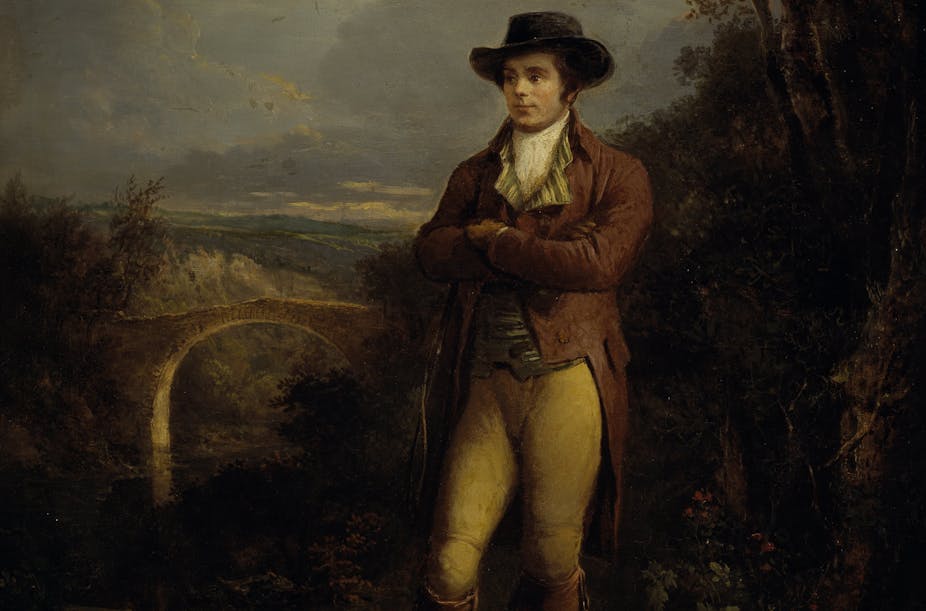Ae Fond Kiss, Auld Lang Syne, O My Love’s Like a Red, Red Rose – all celebrated Robert Burns songs. Many Scots will have a favourite performance, too: maybe Eddie Reader’s characterful renditions or Dick Gaughan’s more epic performances or Kenneth McKellar’s White Heather Club interpretations.
Yet none of these are as the songs would have sounded towards the end of the 18th century. Burns collected and wrote the vast majority of his songs for two rather prestigious collections: the six volume Scots Musical Museum published by Edinburgh printer James Johnson and George Thomson’s opulent Select Collection of Original Scottish Airs.
Both came with rather classical arrangements by the likes of Joseph Haydn and Beethoven, aimed at a highbrow audience. It wouldn’t have been Burns’ farmer friends purchasing such books but rather his subscribers, patrons and merchant friends. Eddie Reader fans might want to brace themselves.
The project
We have been working on Burns’ songs as part of a five-year research project called Editing Robert Burns for the 21st Century. To explore where they came from, we enlisted 11 music students to produce 25 recordings using the two original publications as our performance texts (included below are two lesser known songs: Does Haughty Gaul Invasion Threat and Scroggam, My Dearie).
Through a series of workshops they learned what an 18th-century singing lesson would have been like and how 18th-century dress might have affected their breathing or playing. They worked on the songs with professional coaching, using instruments of the time: gut-stringed violins and cellos, harpsichord and an early version of the piano called the fortepiano. To add a sense of period environment, we recorded the performances at Glasgow’s Pollok House – not a venue that Burns visited himself, but one built during his lifetime.
Everyone found it challenging to perform the songs with their original instrumental accompaniments and sometimes they needed to amend things that didn’t work comfortably. Several performers struggled with the keys of the songs – often the singer was having to sing in too high a key or where the melodies ranged between very high and low notes. This was common for fiddle tunes, which were often the melodic basis of Burns’ songs.
What was really noticeable was how difficult some of the Thomson accompaniments were. They demanded that players could read music fluently and play to a high level of skill. This would have been a problem for many amateur players in Burns’ day, since these publications were intended to encourage people to play the songs at home.
Incidentally the original compositions were even more complicated: Thomson had to ask the likes of Beethoven to supply him with simpler piano parts for the young ladies of Edinburgh. (The Scots Musical Museum songs are musically simpler and not so prescriptive, so there’s more choice in how you perform them.)
The real Burns needn’t stand up
There is little doubt that Burns enjoyed and was inspired by a good song whether in his own front room, at the harvest or in his local howff. But after he first visited Edinburgh in 1787 and met James Johnson, he was inspired by performances in the city’s drawing rooms and performed his poetry to people who both produced and bought the song collections of the day.
When he was asked to contribute songs for two of these collections, he threw himself into it with “the impulse of enthusiasm”, as he put it, contributing many old fiddle standards and in many cases writing entirely new words for them.
All subsequent editions of Burns removed the original accompaniments and published only words with melodies or names of tunes alongside. This enabled lots of different kinds of performances, which meant later Burns enthusiasts could locate the music in a setting more “in tune” with the common man – keeping the songs very much alive in popular music culture along the way.
There’s certainly nothing wrong with this direction of travel, so long as we recognise how these songs originally sounded. We really hope people will enjoy the songs we’ve recorded, even if these fancy original accompaniments might not be everyone’s cup of tea.
But we are being untrue to the great man if we don’t acknowledge that his songs first appeared to his own public in this way. We ought to pause and appreciate them for what they are.

